Annotated Bibliography: Modern Urban Lifestyles & the Environment
VerifiedAdded on 2023/06/13
|5
|1150
|268
Annotated Bibliography
AI Summary
This annotated bibliography explores the environmental impact of personal lifestyle choices in modern urban settings. It examines the effects of increased automobile use, the potential of car-sharing services to reduce greenhouse gas emissions, and the ecological footprint of cities. The bibliography includes annotations of scholarly articles discussing transport policies, consumer behavior, and urban density, highlighting both short-term and long-term environmental consequences such as air pollution and climate change. It emphasizes the need for sustainable transport alternatives and resource consumption policies to mitigate the negative impacts of urban lifestyles on the environment. Desklib offers more resources like this to aid students in their studies.
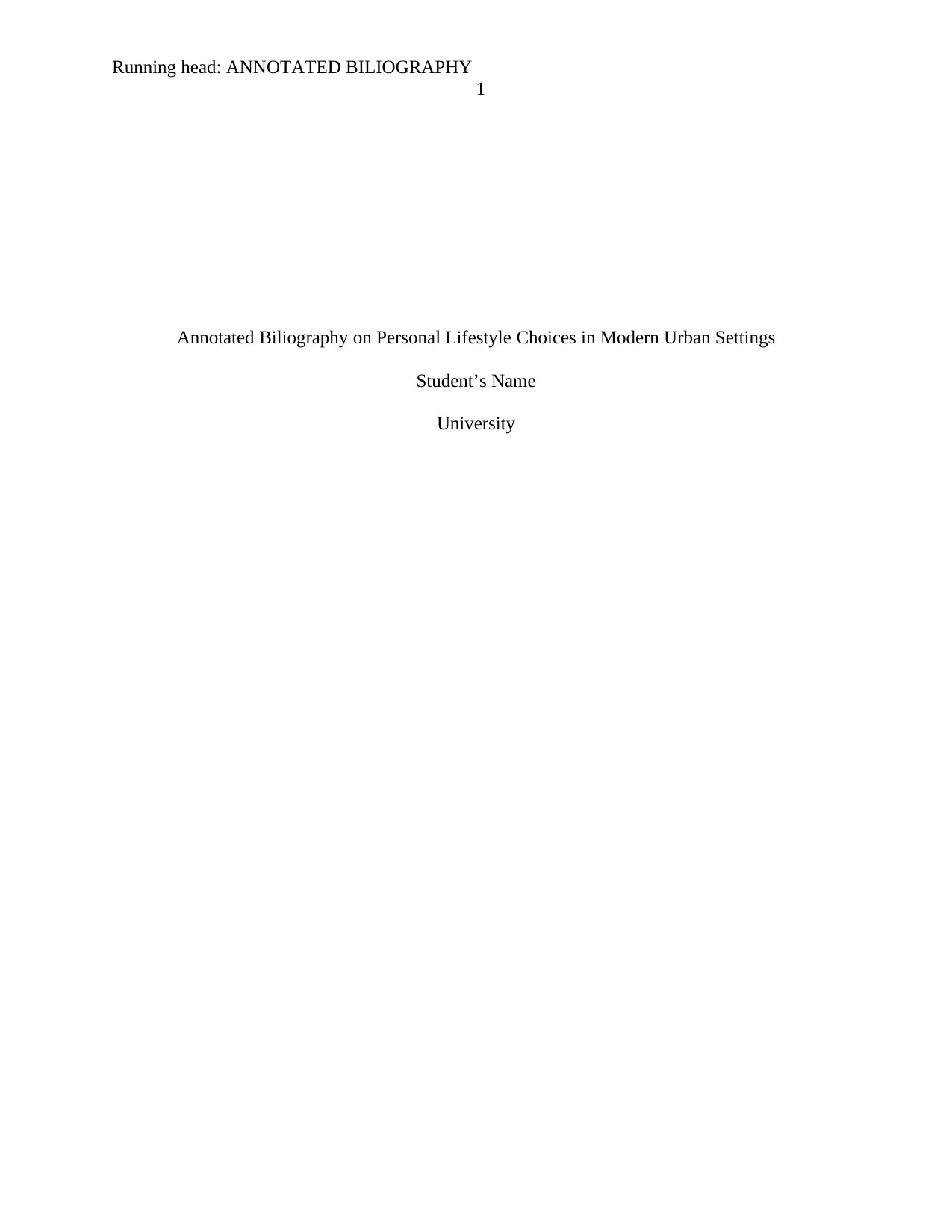
Running head: ANNOTATED BILIOGRAPHY
1
Annotated Biliography on Personal Lifestyle Choices in Modern Urban Settings
Student’s Name
University
1
Annotated Biliography on Personal Lifestyle Choices in Modern Urban Settings
Student’s Name
University
Paraphrase This Document
Need a fresh take? Get an instant paraphrase of this document with our AI Paraphraser
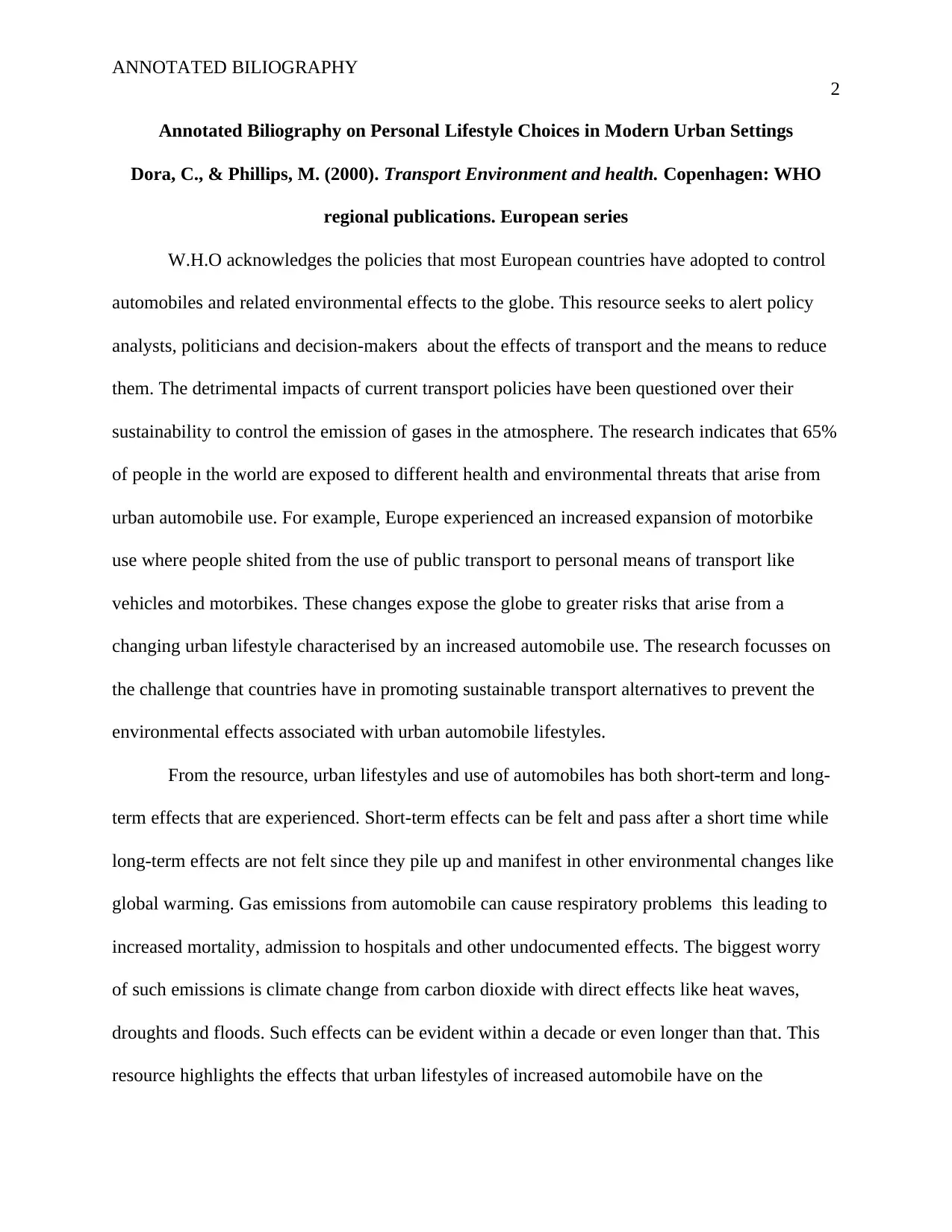
ANNOTATED BILIOGRAPHY
2
Annotated Biliography on Personal Lifestyle Choices in Modern Urban Settings
Dora, C., & Phillips, M. (2000). Transport Environment and health. Copenhagen: WHO
regional publications. European series
W.H.O acknowledges the policies that most European countries have adopted to control
automobiles and related environmental effects to the globe. This resource seeks to alert policy
analysts, politicians and decision-makers about the effects of transport and the means to reduce
them. The detrimental impacts of current transport policies have been questioned over their
sustainability to control the emission of gases in the atmosphere. The research indicates that 65%
of people in the world are exposed to different health and environmental threats that arise from
urban automobile use. For example, Europe experienced an increased expansion of motorbike
use where people shited from the use of public transport to personal means of transport like
vehicles and motorbikes. These changes expose the globe to greater risks that arise from a
changing urban lifestyle characterised by an increased automobile use. The research focusses on
the challenge that countries have in promoting sustainable transport alternatives to prevent the
environmental effects associated with urban automobile lifestyles.
From the resource, urban lifestyles and use of automobiles has both short-term and long-
term effects that are experienced. Short-term effects can be felt and pass after a short time while
long-term effects are not felt since they pile up and manifest in other environmental changes like
global warming. Gas emissions from automobile can cause respiratory problems this leading to
increased mortality, admission to hospitals and other undocumented effects. The biggest worry
of such emissions is climate change from carbon dioxide with direct effects like heat waves,
droughts and floods. Such effects can be evident within a decade or even longer than that. This
resource highlights the effects that urban lifestyles of increased automobile have on the
2
Annotated Biliography on Personal Lifestyle Choices in Modern Urban Settings
Dora, C., & Phillips, M. (2000). Transport Environment and health. Copenhagen: WHO
regional publications. European series
W.H.O acknowledges the policies that most European countries have adopted to control
automobiles and related environmental effects to the globe. This resource seeks to alert policy
analysts, politicians and decision-makers about the effects of transport and the means to reduce
them. The detrimental impacts of current transport policies have been questioned over their
sustainability to control the emission of gases in the atmosphere. The research indicates that 65%
of people in the world are exposed to different health and environmental threats that arise from
urban automobile use. For example, Europe experienced an increased expansion of motorbike
use where people shited from the use of public transport to personal means of transport like
vehicles and motorbikes. These changes expose the globe to greater risks that arise from a
changing urban lifestyle characterised by an increased automobile use. The research focusses on
the challenge that countries have in promoting sustainable transport alternatives to prevent the
environmental effects associated with urban automobile lifestyles.
From the resource, urban lifestyles and use of automobiles has both short-term and long-
term effects that are experienced. Short-term effects can be felt and pass after a short time while
long-term effects are not felt since they pile up and manifest in other environmental changes like
global warming. Gas emissions from automobile can cause respiratory problems this leading to
increased mortality, admission to hospitals and other undocumented effects. The biggest worry
of such emissions is climate change from carbon dioxide with direct effects like heat waves,
droughts and floods. Such effects can be evident within a decade or even longer than that. This
resource highlights the effects that urban lifestyles of increased automobile have on the
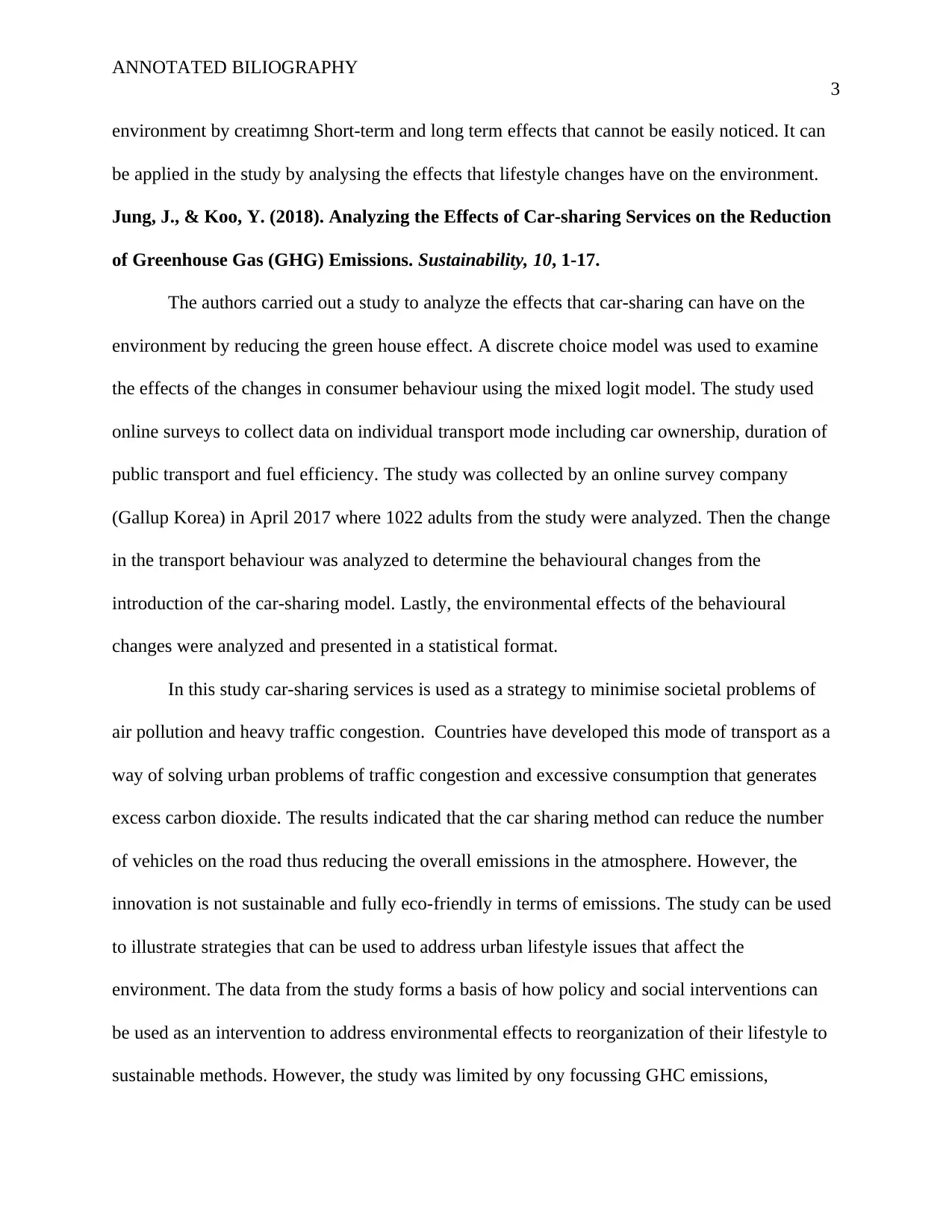
ANNOTATED BILIOGRAPHY
3
environment by creatimng Short-term and long term effects that cannot be easily noticed. It can
be applied in the study by analysing the effects that lifestyle changes have on the environment.
Jung, J., & Koo, Y. (2018). Analyzing the Effects of Car-sharing Services on the Reduction
of Greenhouse Gas (GHG) Emissions. Sustainability, 10, 1-17.
The authors carried out a study to analyze the effects that car-sharing can have on the
environment by reducing the green house effect. A discrete choice model was used to examine
the effects of the changes in consumer behaviour using the mixed logit model. The study used
online surveys to collect data on individual transport mode including car ownership, duration of
public transport and fuel efficiency. The study was collected by an online survey company
(Gallup Korea) in April 2017 where 1022 adults from the study were analyzed. Then the change
in the transport behaviour was analyzed to determine the behavioural changes from the
introduction of the car-sharing model. Lastly, the environmental effects of the behavioural
changes were analyzed and presented in a statistical format.
In this study car-sharing services is used as a strategy to minimise societal problems of
air pollution and heavy traffic congestion. Countries have developed this mode of transport as a
way of solving urban problems of traffic congestion and excessive consumption that generates
excess carbon dioxide. The results indicated that the car sharing method can reduce the number
of vehicles on the road thus reducing the overall emissions in the atmosphere. However, the
innovation is not sustainable and fully eco-friendly in terms of emissions. The study can be used
to illustrate strategies that can be used to address urban lifestyle issues that affect the
environment. The data from the study forms a basis of how policy and social interventions can
be used as an intervention to address environmental effects to reorganization of their lifestyle to
sustainable methods. However, the study was limited by ony focussing GHC emissions,
3
environment by creatimng Short-term and long term effects that cannot be easily noticed. It can
be applied in the study by analysing the effects that lifestyle changes have on the environment.
Jung, J., & Koo, Y. (2018). Analyzing the Effects of Car-sharing Services on the Reduction
of Greenhouse Gas (GHG) Emissions. Sustainability, 10, 1-17.
The authors carried out a study to analyze the effects that car-sharing can have on the
environment by reducing the green house effect. A discrete choice model was used to examine
the effects of the changes in consumer behaviour using the mixed logit model. The study used
online surveys to collect data on individual transport mode including car ownership, duration of
public transport and fuel efficiency. The study was collected by an online survey company
(Gallup Korea) in April 2017 where 1022 adults from the study were analyzed. Then the change
in the transport behaviour was analyzed to determine the behavioural changes from the
introduction of the car-sharing model. Lastly, the environmental effects of the behavioural
changes were analyzed and presented in a statistical format.
In this study car-sharing services is used as a strategy to minimise societal problems of
air pollution and heavy traffic congestion. Countries have developed this mode of transport as a
way of solving urban problems of traffic congestion and excessive consumption that generates
excess carbon dioxide. The results indicated that the car sharing method can reduce the number
of vehicles on the road thus reducing the overall emissions in the atmosphere. However, the
innovation is not sustainable and fully eco-friendly in terms of emissions. The study can be used
to illustrate strategies that can be used to address urban lifestyle issues that affect the
environment. The data from the study forms a basis of how policy and social interventions can
be used as an intervention to address environmental effects to reorganization of their lifestyle to
sustainable methods. However, the study was limited by ony focussing GHC emissions,
⊘ This is a preview!⊘
Do you want full access?
Subscribe today to unlock all pages.

Trusted by 1+ million students worldwide
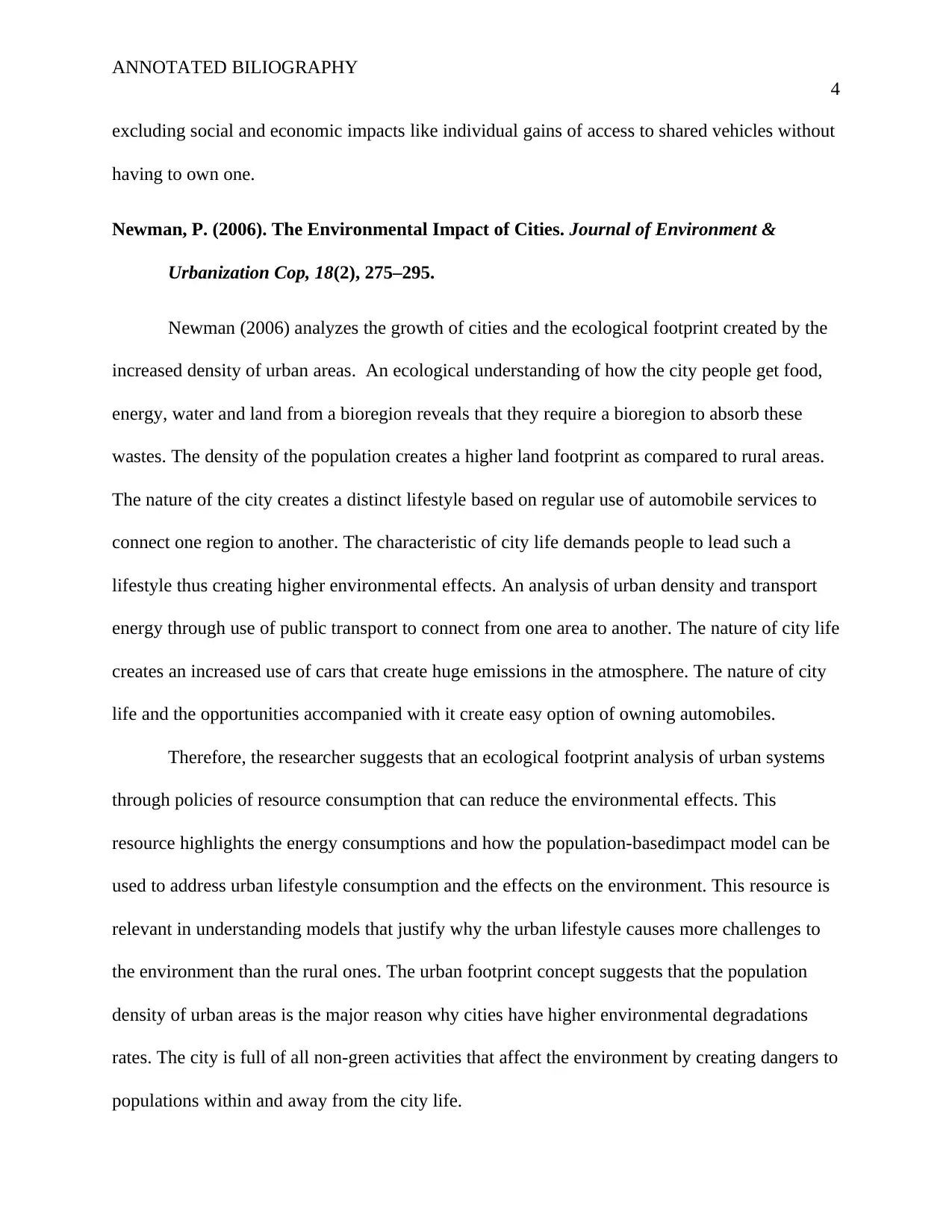
ANNOTATED BILIOGRAPHY
4
excluding social and economic impacts like individual gains of access to shared vehicles without
having to own one.
Newman, P. (2006). The Environmental Impact of Cities. Journal of Environment &
Urbanization Cop, 18(2), 275–295.
Newman (2006) analyzes the growth of cities and the ecological footprint created by the
increased density of urban areas. An ecological understanding of how the city people get food,
energy, water and land from a bioregion reveals that they require a bioregion to absorb these
wastes. The density of the population creates a higher land footprint as compared to rural areas.
The nature of the city creates a distinct lifestyle based on regular use of automobile services to
connect one region to another. The characteristic of city life demands people to lead such a
lifestyle thus creating higher environmental effects. An analysis of urban density and transport
energy through use of public transport to connect from one area to another. The nature of city life
creates an increased use of cars that create huge emissions in the atmosphere. The nature of city
life and the opportunities accompanied with it create easy option of owning automobiles.
Therefore, the researcher suggests that an ecological footprint analysis of urban systems
through policies of resource consumption that can reduce the environmental effects. This
resource highlights the energy consumptions and how the population-basedimpact model can be
used to address urban lifestyle consumption and the effects on the environment. This resource is
relevant in understanding models that justify why the urban lifestyle causes more challenges to
the environment than the rural ones. The urban footprint concept suggests that the population
density of urban areas is the major reason why cities have higher environmental degradations
rates. The city is full of all non-green activities that affect the environment by creating dangers to
populations within and away from the city life.
4
excluding social and economic impacts like individual gains of access to shared vehicles without
having to own one.
Newman, P. (2006). The Environmental Impact of Cities. Journal of Environment &
Urbanization Cop, 18(2), 275–295.
Newman (2006) analyzes the growth of cities and the ecological footprint created by the
increased density of urban areas. An ecological understanding of how the city people get food,
energy, water and land from a bioregion reveals that they require a bioregion to absorb these
wastes. The density of the population creates a higher land footprint as compared to rural areas.
The nature of the city creates a distinct lifestyle based on regular use of automobile services to
connect one region to another. The characteristic of city life demands people to lead such a
lifestyle thus creating higher environmental effects. An analysis of urban density and transport
energy through use of public transport to connect from one area to another. The nature of city life
creates an increased use of cars that create huge emissions in the atmosphere. The nature of city
life and the opportunities accompanied with it create easy option of owning automobiles.
Therefore, the researcher suggests that an ecological footprint analysis of urban systems
through policies of resource consumption that can reduce the environmental effects. This
resource highlights the energy consumptions and how the population-basedimpact model can be
used to address urban lifestyle consumption and the effects on the environment. This resource is
relevant in understanding models that justify why the urban lifestyle causes more challenges to
the environment than the rural ones. The urban footprint concept suggests that the population
density of urban areas is the major reason why cities have higher environmental degradations
rates. The city is full of all non-green activities that affect the environment by creating dangers to
populations within and away from the city life.
Paraphrase This Document
Need a fresh take? Get an instant paraphrase of this document with our AI Paraphraser
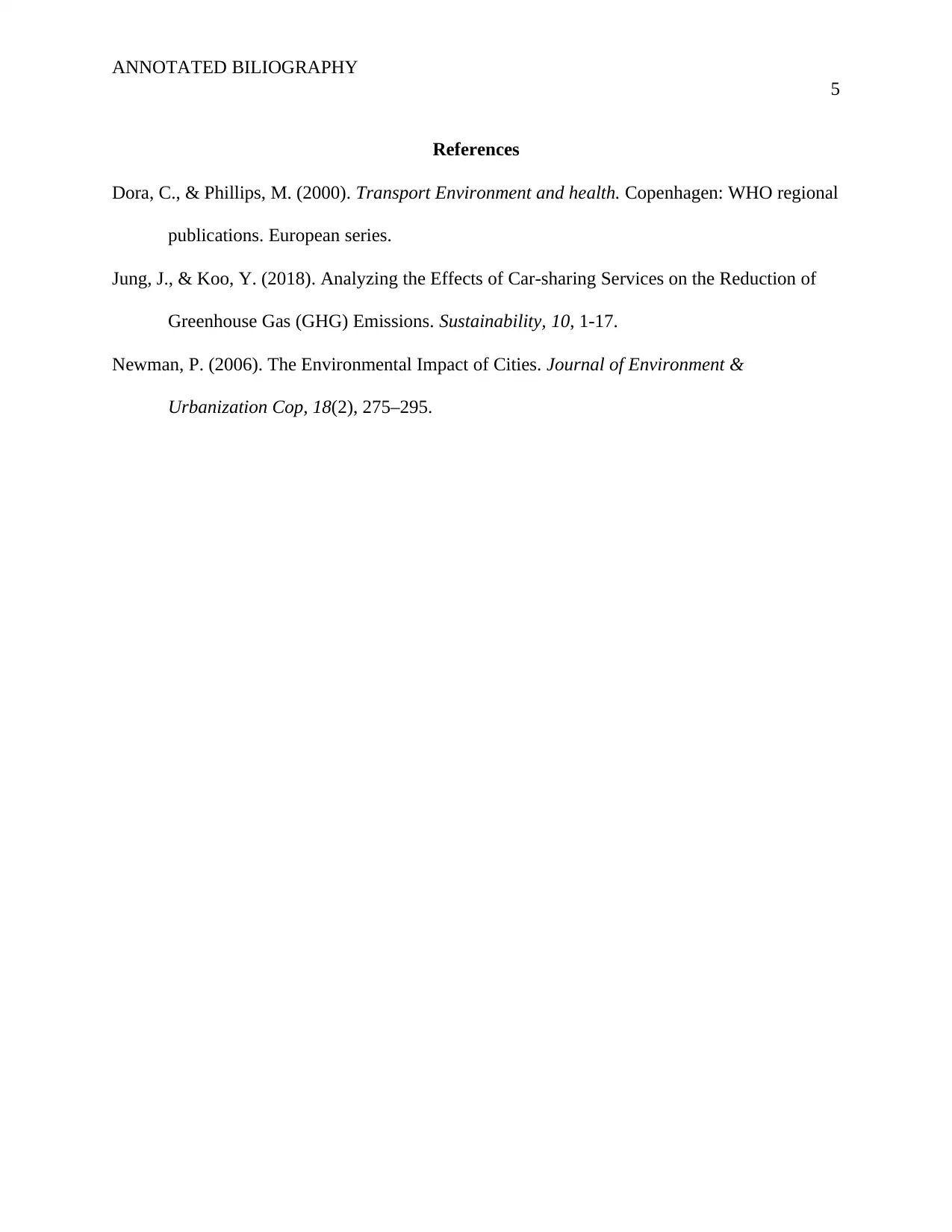
ANNOTATED BILIOGRAPHY
5
References
Dora, C., & Phillips, M. (2000). Transport Environment and health. Copenhagen: WHO regional
publications. European series.
Jung, J., & Koo, Y. (2018). Analyzing the Effects of Car-sharing Services on the Reduction of
Greenhouse Gas (GHG) Emissions. Sustainability, 10, 1-17.
Newman, P. (2006). The Environmental Impact of Cities. Journal of Environment &
Urbanization Cop, 18(2), 275–295.
5
References
Dora, C., & Phillips, M. (2000). Transport Environment and health. Copenhagen: WHO regional
publications. European series.
Jung, J., & Koo, Y. (2018). Analyzing the Effects of Car-sharing Services on the Reduction of
Greenhouse Gas (GHG) Emissions. Sustainability, 10, 1-17.
Newman, P. (2006). The Environmental Impact of Cities. Journal of Environment &
Urbanization Cop, 18(2), 275–295.
1 out of 5
Related Documents
Your All-in-One AI-Powered Toolkit for Academic Success.
+13062052269
info@desklib.com
Available 24*7 on WhatsApp / Email
![[object Object]](/_next/static/media/star-bottom.7253800d.svg)
Unlock your academic potential
Copyright © 2020–2025 A2Z Services. All Rights Reserved. Developed and managed by ZUCOL.





